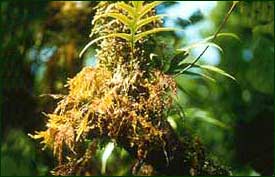Philippine Mosses
Although mosses and algae are two distinct groups, they are referred to in Tagalog by the same general name, lumot. Both are small plants with little or no differentiation into roots, stems, or leaves. Because both groups lack tissues for the efficient circulation and storage of water, algae and mosses require constant moisture. The algae have easily solved this problem by remaining aquatic. The mosses have developed several adaptations that enable them to live on land, but these are not sufficient to withstand more than brief and rather minor water deficits.
In lowland forests, a limited number of moss species thrive in damp, shady areas where moisture on the ground and water vapor in the atmosphere are always available. A sudden change, however, begins at about1,000 meters on forested mountains throughout the Philippines: Mosses uncommon on lower slopes abruptly form a luxuriant green carpet on almost everything— tree trunks, twigs and branches, rocks and fallen logs, even the surfaces of leaves. The abundance of mosses, especially above 1,700 meters, is the reason such habitats are called "mossy forest." With increasing altitude, on wind-swept slopes and ridge tops, trees in mossy forests are gnarled and only a few meters tall. Mosses festoon their branches and hang like beards, giving the whole forest an eerie feeling.
On the ground, mosses grow very close to each other, forming a dense mat or cushion that can absorb and retain great amounts of water. As new shoots continue to grow, older parts die and are compressed underneath; eventually the layers of dead material turn into peat several meters deep. These layers of peat absorb and distribute the heavy rains on the mountains into the groundwater systemand small forest streams, thus preventing disastrous floods in the lowlands.
The moss flora of the Philippines includes about 700 species, about 50 of which are unique to the country, including one endemic genus, Merrilliobryum. Although mosses are widespread, many species are poorly documented; much more research on these critical indicators of forest vitality is needed.
Original URL: http://archive.fieldmuseum.org/vanishing_treasures/V_Moss.htm

